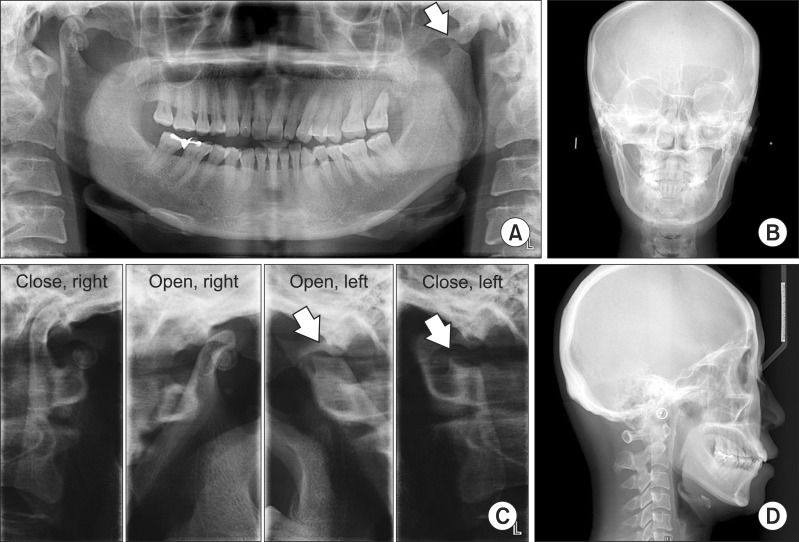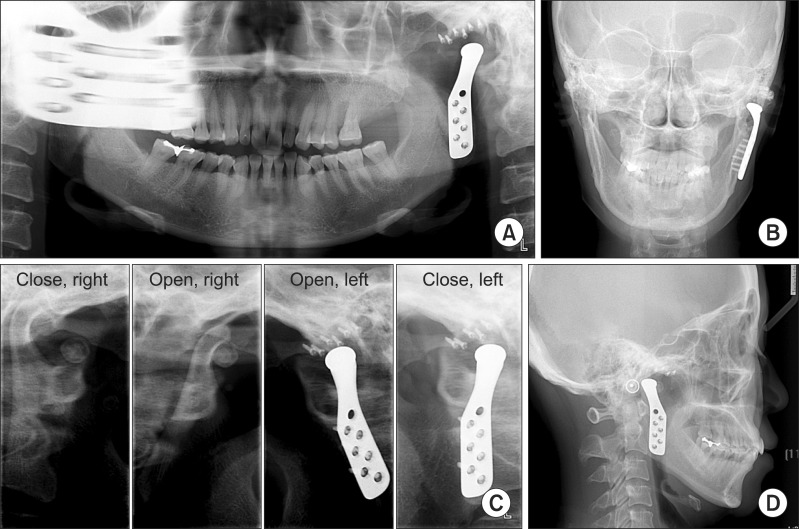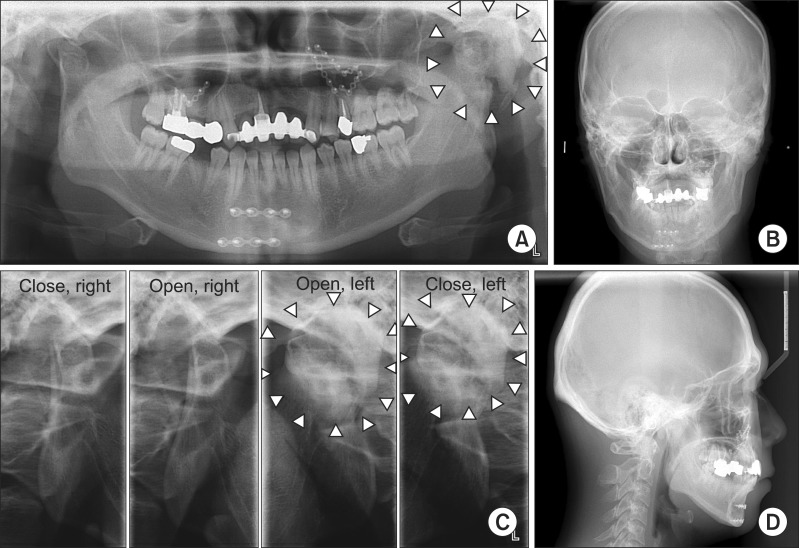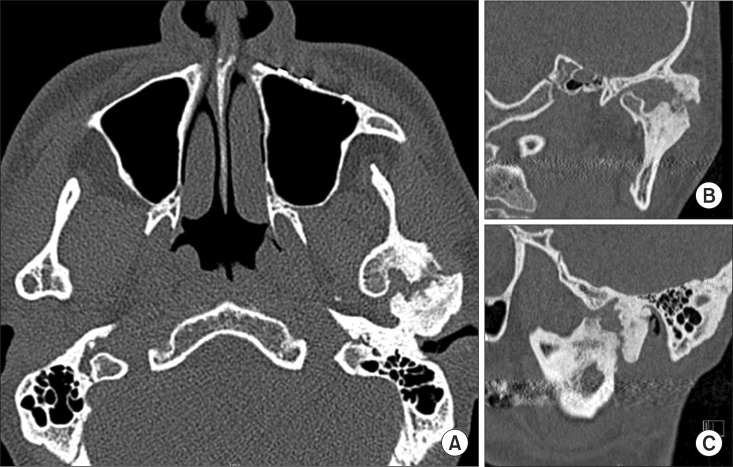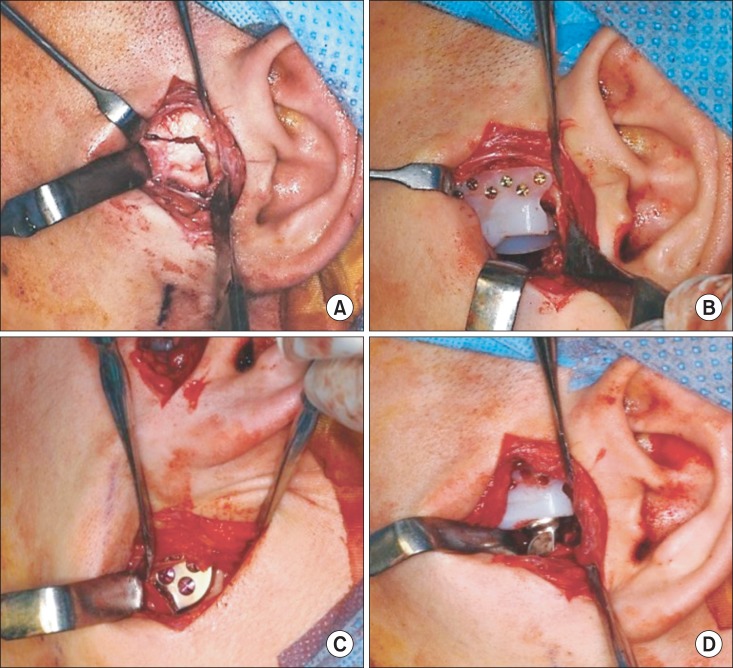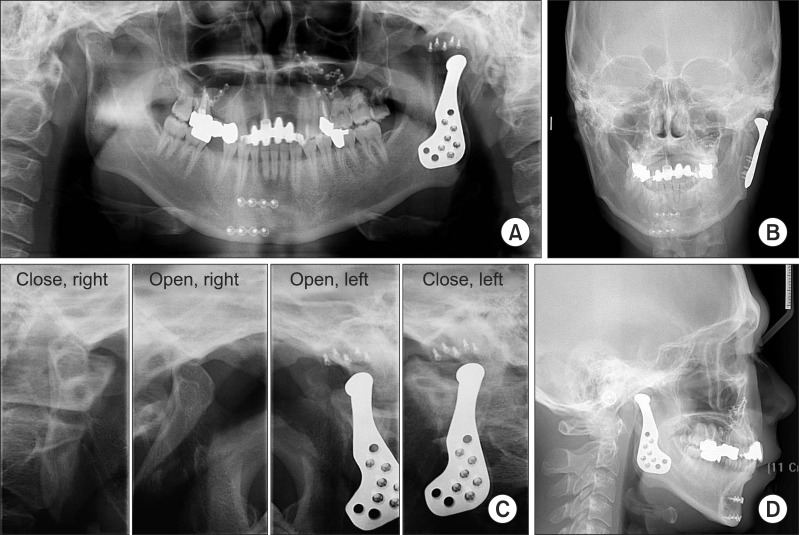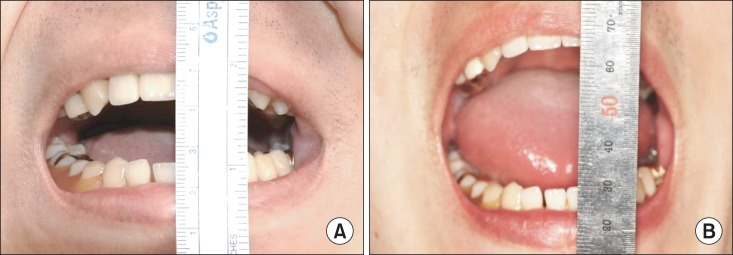J Korean Assoc Oral Maxillofac Surg.
2013 Dec;39(6):297-303. 10.5125/jkaoms.2013.39.6.297.
Alloplastic total temporomandibular joint replacement using stock prosthesis: a one-year follow-up report of two cases
- Affiliations
-
- 1Department of Oral and Maxillofacial Surgery, Gangnam Severance Hospital, College of Dentistry, Yonsei University, Seoul, Korea. omshuh@yuhs.ac
- KMID: 1960981
- DOI: http://doi.org/10.5125/jkaoms.2013.39.6.297
Abstract
- Alloplastic total replacement of the temporomandibular joint (TMJ) was developed in recent decades. In some conditions, previous studies suggested the rationale behind alloplastic TMJ replacement rather than reconstruction with autogenous grafts. Currently, three prosthetic products are available and approved by the US Food and Drug Administration. Among these products, customized prostheses are manufactured, via computer aided design/computer aided manufacturing (CAD/CAM) system for customized design; stock-type prostheses are provided in various sizes and shapes. In this report, two patients (a 50-year-old female who had undergone condylectomy for the treatment of osteochondroma extending to the cranial base on the left condyle, and a 21-year-old male diagnosed with left temporomandibular ankylosis) were treated using the alloplastic total replacement of TMJ using stock prosthesis. The follow-up results of a favorable one-year, short-term therapeutic outcome were obtained for the alloplastic total TMJ replacement using a stock-type prosthesis.
Keyword
MeSH Terms
Figure
Cited by 1 articles
-
Conservative condylectomy alone for the correction of mandibular asymmetry caused by osteochondroma of the mandibular condyle: a report of five cases
Dong Sung Kim, Jae-Young Kim, Chan-Woo Jeong, Kwang-Ho Park, Jong-Ki Huh
J Korean Assoc Oral Maxillofac Surg. 2015;41(5):259-264. doi: 10.5125/jkaoms.2015.41.5.259.
Reference
-
1. Driemel O, Braun S, Müller-Richter UD, Behr M, Reichert TE, Kunkel M, et al. Historical development of alloplastic temporomandibular joint replacement after 1945 and state of the art. Int J Oral Maxillofac Surg. 2009; 38:909–920. PMID: 19464145.
Article2. Westermark A, Leiggener C, Aagaard E, Lindskog S. Histological findings in soft tissues around temporomandibular joint prostheses after up to eight years of function. Int J Oral Maxillofac Surg. 2011; 40:18–25. PMID: 21044827.
Article3. Mercuri LG. Alloplastic temporomandibular joint reconstruction. Oral Surg Oral Med Oral Pathol Oral Radiol Endod. 1998; 85:631–637. PMID: 9638694.
Article4. Mercuri LG, Edibam NR, Giobbie-Hurder A. Fourteen-year follow-up of a patient-fitted total temporomandibular joint reconstruction system. J Oral Maxillofac Surg. 2007; 65:1140–1148. PMID: 17517298.
Article5. Leandro LF, Ono HY, Loureiro CC, Marinho K, Guevara HA. A ten-year experience and follow-up of three hundred patients fitted with the Biomet/Lorenz Microfixation TMJ replacement system. Int J Oral Maxillofac Surg. 2013; 42:1007–1013. PMID: 23769150.
Article6. Huh JK. Alloplastic total temporomandibular joint replacement. J Korean Dent Assoc. 2012; 50:256–261.7. Granquist EJ, Quinn PD. Total reconstruction of the temporomandibular joint with a stock prosthesis. Atlas Oral Maxillofac Surg Clin North Am. 2011; 19:221–232. PMID: 21878254.
Article8. Mercuri LG. Total joint reconstruction--autologous or alloplastic. Oral Maxillofac Surg Clin North Am. 2006; 18:399–410. PMID: 18088840.
Article9. Mercuri LG. A rationale for total alloplastic temporomandibular joint reconstruction in the management of idiopathic/progressive condylar resorption. J Oral Maxillofac Surg. 2007; 65:1600–1609. PMID: 17656290.
Article10. Chung CJ, Choi YJ, Kim IS, Huh JK, Kim HG, Kim KH. Total alloplastic temporomandibular joint reconstruction combined with orthodontic treatment in a patient with idiopathic condylar resorption. Am J Orthod Dentofacial Orthop. 2011; 140:404–417. PMID: 21889086.
Article11. Mercuri LG. The use of alloplastic prostheses for temporomandibular joint reconstruction. J Oral Maxillofac Surg. 2000; 58:70–75. PMID: 10632168.
Article12. Guarda-Nardini L, Manfredini D, Ferronato G. Temporomandibular joint total replacement prosthesis: current knowledge and considerations for the future. Int J Oral Maxillofac Surg. 2008; 37:103–110. PMID: 18022347.
Article13. Mercuri LG. Alloplastic temporomandibular joint replacement: rationale for the use of custom devices. Int J Oral Maxillofac Surg. 2012; 41:1033–1040. PMID: 22771166.
Article14. Jones RH. Temporomandibular joint reconstruction with total alloplastic joint replacement. Aust Dent J. 2011; 56:85–91. PMID: 21332746.
Article15. Westermark A. Total reconstruction of the temporomandibular joint. Up to 8 years of follow-up of patients treated with Biomet(®) total joint prostheses. Int J Oral Maxillofac Surg. 2010; 39:951–955. PMID: 20594807.
Article16. Granquist EJ, Chou JC, Giannakopoulos H, Livolsi VA, Quinn PD. Post-surgical neuromas in patients with total alloplastic temporomandibular joint reconstruction: a retrospective case series. Int J Oral Maxillofac Surg. 2011; 40:366–371. PMID: 21123031.
Article
- Full Text Links
- Actions
-
Cited
- CITED
-
- Close
- Share
- Similar articles
-
- Treatment of Temporomandibular Joint Disorder by Alloplastic Total Temporomandibular Joint Replacement
- Temporomandibular joint reconstruction with alloplastic prosthesis: the outcomes of four cases
- Comparison of Costochondral Graft and Customized Total Joint Reconstruction for Treatments of Temporomandibular Joint Replacement
- A Case Report of Temporomandibular Bilateral Osseous Ankylosis Treated by Total Joint Replacement in Ankylosing Spondylitis
- CAD/CAM-assisted total joint replacement for correction of facial asymmetry caused by large osteoma of mandibular condyle


